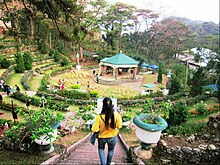Camp John Hay
This article needs additional citations for verification. (January 2018) |
 | |
 | |
| Project | |
|---|---|
| Developer | Camp John Hay Development Corp. |
| Website | campjohnhay |
| Physical features | |
| Major buildings | Bell House, Bell Amphitheater, Manor Hotel, Forest Lodge |
| Public spaces | History Trail, Secret Garden, Cemetery of Negativism |
| Location | |
| Coordinates: 16°23′56″N 120°36′34″E / 16.398912°N 120.609463°E | |
| Location | Baguio, Philippines |
Camp John Hay is a mixed-used development which serves as a tourist destination and forest watershed reservation in Baguio, Philippines which was formerly a military base of the United States Armed Forces.
History[edit]

The United States 48th Infantry Unit under Captain Robert Rudd established Hill Station in the current site of Camp John Hay in 1900 during the Philippine-American war. The site is referred to the locals, the Ibalois, as "Kafagway" and is owned by Ibaloi leader Mateo Cariño. 213 hectares (530 acres) of the land was then designated as "Camp John Hay", a military reservation for American soldiers, in October 1903 when US President Theodore Roosevelt signed a presidential order. American military personnel were given a place to refuge from the relative hotter temperature of the lowlands.[1]
In December 1941, Japanese warplanes dropped 72 bombs over the main gate of the camp during the onset of World War II in the Philippines. Camp John Hay served as an internment camp of the Imperial Japanese forces as well as the headquarters of General Tomoyuki Yamashita during the Japanese occupation period. When the Japanese forces in the archipelago capitulated, Yamashita surrendered to the Allied forces at Camp John Hay, specifically at the High Commissioner's residence which was later renamed as the Ambassador's Residence.[1]
After the war, Camp John Hay was converted into John Hay Air Base in 1955 and remained under the control of the Americans until it was officially turned over the Philippine government in 1991. The former military installation was made into a human resource development hub, and forest watershed reservation. The site became a tourist attraction.[1]
On April 3, 2024, the Supreme Court En banc's decision by Justice Japar Dimaampao upheld the arbitral ruling and ordered Camp John Hay Development Corp. to vacate a portion of the John Hay Special Economic Zone it leased from the Bases Conversion Development Authority. In G.R. Nos. 219421 and 241772 (BCDA v. CJH Development Corporation, et al.; CJH Development Corporation v. COA and BCDA), the High Tribunal lifted the injunction on eviction of Camp John Hay developer specifically mandating the return to BCDA of the 247-hectare leased property together with all improvements and the BCDA in turn must refund to CJH DevCo its total rent paid amounting to P1.4 billion.[2]
[3]
Features[edit]

Historic buildings and structures[edit]
The Bell House, a historic structure named after Major General Franklin Bell is situated at the camp's Historical Core. Besides the house is the Bell Amphitheater which was designed by Bell himself.[4]
Gardens[edit]
Camp John Hay's history is featured through markers installed at the History Trail and Secret Garden.[4] The Cemetery of Negativism nearby or the Lost Cemetery is a small area within Camp John Hay. The "cemetery" established by then-commanding general of the John Hay Air Station, John Hightower in the early 1980s.[5] It serves a symbolic burial site for negativism. The Amphiteather near Bell House also hosts a gazebo which is encircled by a multi-terraced flower garden.[4]
Others[edit]
Manor Hotel and Forest Lodge are the two hotels operated by the management of Camp John Hay and are situated within the area.[4]
See also[edit]
External links[edit]
 Media related to Camp John Hay at Wikimedia Commons
Media related to Camp John Hay at Wikimedia Commons
References[edit]
- ^ a b c "History". Camp John Hay. Retrieved January 15, 2018.
- ^ Bautista, Jane (April 11, 2024). "SC lifts freeze order on eviction of Camp John Hay developer". Philippine Daily Inquirer. Retrieved April 13, 2024.
- ^ "SC Upholds Arbitral Ruling Ordering CJH Dev't Corp. to Vacate John Hay Special Economic Zone". Supreme Court of the Philippines. April 10, 2024. Retrieved April 13, 2024.
- ^ a b c d Concepcion, Pocholo (December 12, 2015). "Enjoy Camp John Hay while you can". Philippine Daily Inquirer. Retrieved January 16, 2018.
- ^ "Odd cemeteries in the Philippines". CNN Philippines. November 1, 2016. Archived from the original on January 17, 2018. Retrieved January 16, 2018.

